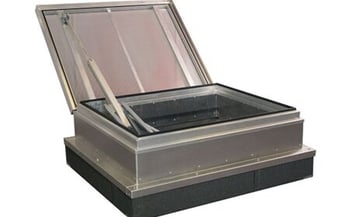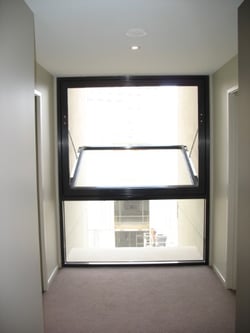 EN 12101 "Smoke and Heat Control Systems - Part 2: Specification for Natural Heat and Smoke Exhaust Ventilators" is a European test standard that all smoke ventilators need to be designed and manufactured to in order to operate effectively. Crucially, it provides a set brief for how a ventilator should perform when in operation, specifying key points like the number of lifecycles it should be tested to, snow load it should be able to lift, wind load it should withstand, aerodynamic free area it should achieve and the temperature at which it should operate, without reducing in area.
EN 12101 "Smoke and Heat Control Systems - Part 2: Specification for Natural Heat and Smoke Exhaust Ventilators" is a European test standard that all smoke ventilators need to be designed and manufactured to in order to operate effectively. Crucially, it provides a set brief for how a ventilator should perform when in operation, specifying key points like the number of lifecycles it should be tested to, snow load it should be able to lift, wind load it should withstand, aerodynamic free area it should achieve and the temperature at which it should operate, without reducing in area.
The standard is in place to ensure that all smoke ventilation system components meet the regulatory and quality standards that make them safe. It also ensures that the components used in the manufacture of the ventilator work as one complete unit and will operate safely in a fire when heat can cause items to buckle, bend or twist.
Unfortunately, as our engineers have discovered on multiple occasions, some installation and maintenance companies choose to swap out or retrofit other manufacturers’ actuator systems to existing ventilators, which could potentially render that ventilator ineffective in a fire. Due to the unknown nature of two non-original components being used together, the ventilator’s performance cannot be guaranteed. As they were not part of the original design, this will also void the EN 12101 certification and could have serious implications for the safety of the building occupants and insurance.
To maintain the EN 12101 standard, any components that need to be replaced or repaired need to be done using the same component as what the system was designed with. Alternatively, if that particular part is no longer available, a component with a similar performance spec and that has also been tested to EN 12101 needs to be used.
 An extreme example of “retrofitting-gone-wrong” and of mixing non-compliant components we have seen is where a company has taken a regular, double-glazed PVC plastic window and installed an actuator on it, calling it a smoke vent. In the past this has been a regular practice. Not withstanding the health and safety impacts that installing heavy windows with no safety restraints could have, smoke ventilators have to face extreme heat in the event of a fire and this solution would almost certainly have failed and been rendered inoperable. Not only would the window not be providing the necessary smoke ventilation, but it could actually melt and warp closed, actively keeping the smoke from escaping.
An extreme example of “retrofitting-gone-wrong” and of mixing non-compliant components we have seen is where a company has taken a regular, double-glazed PVC plastic window and installed an actuator on it, calling it a smoke vent. In the past this has been a regular practice. Not withstanding the health and safety impacts that installing heavy windows with no safety restraints could have, smoke ventilators have to face extreme heat in the event of a fire and this solution would almost certainly have failed and been rendered inoperable. Not only would the window not be providing the necessary smoke ventilation, but it could actually melt and warp closed, actively keeping the smoke from escaping.
Other issues that have been often encountered include:
- Using completely inappropriate fixings to secure the actuators making the windows unsafe
- Unwittingly creating fall from height risks through large opening vents with incorrect or no guarding
If you think you have something like this installed in your building, please get in touch with us immediately as this not a safe or compliant smoke ventilation solution.
For complete peace of mind, book a free building survey with Colt. Our engineers will be able to let you know if there are any improvements needed to keep your buildings safe and compliant.
